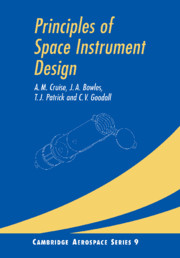Book contents
3 - Thermal design
Published online by Cambridge University Press: 12 November 2009
Summary
General background
Preamble
The temperature of laboratories in which space experiments are assembled, calibrated and tested is nominally 20°C (293 K) and it is thus not surprising that in general this is a most desirable operating temperature for that same equipment in space. There is nothing unique about this temperature. It is, within a relatively small band, a typical temperature that is experienced anywhere on the Earth's surface and, as fossil records show, has remained remarkably stable over billions of years.
Interestingly an Earth satellite is in a similar thermal environment, modified of course by the presence of the Earth. It is instructive therefore to consider what each of these thermal environments are and in what subtle ways they differ.
The temperature of the Earth
Essentially the Earth's surface temperature of about 290K results from the fact that the Earth orbits the Sun, which has a luminosity of 3.9 × 1026 W, and is at a mean distance of 1 Astronomical Unit (AU) from it, that is 1.5 × 1011 m. The emitted solar power crosses the surfaces of a succession of concentric, imaginary spheres centered on the Sun. The sphere which intercepts the Earth has a radius equal to the Astronomical Unit, so it is a simple calculation to show that the energy flux density at the distance of the Earth is 1.37 kWm−2. Thus the power equivalent to a one bar electric fire is received across every square metre of the Earth's projected area.
- Type
- Chapter
- Information
- Principles of Space Instrument Design , pp. 73 - 156Publisher: Cambridge University PressPrint publication year: 1998

